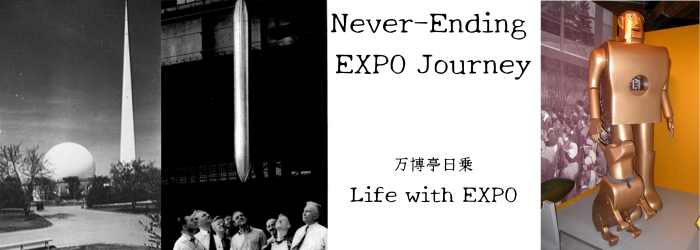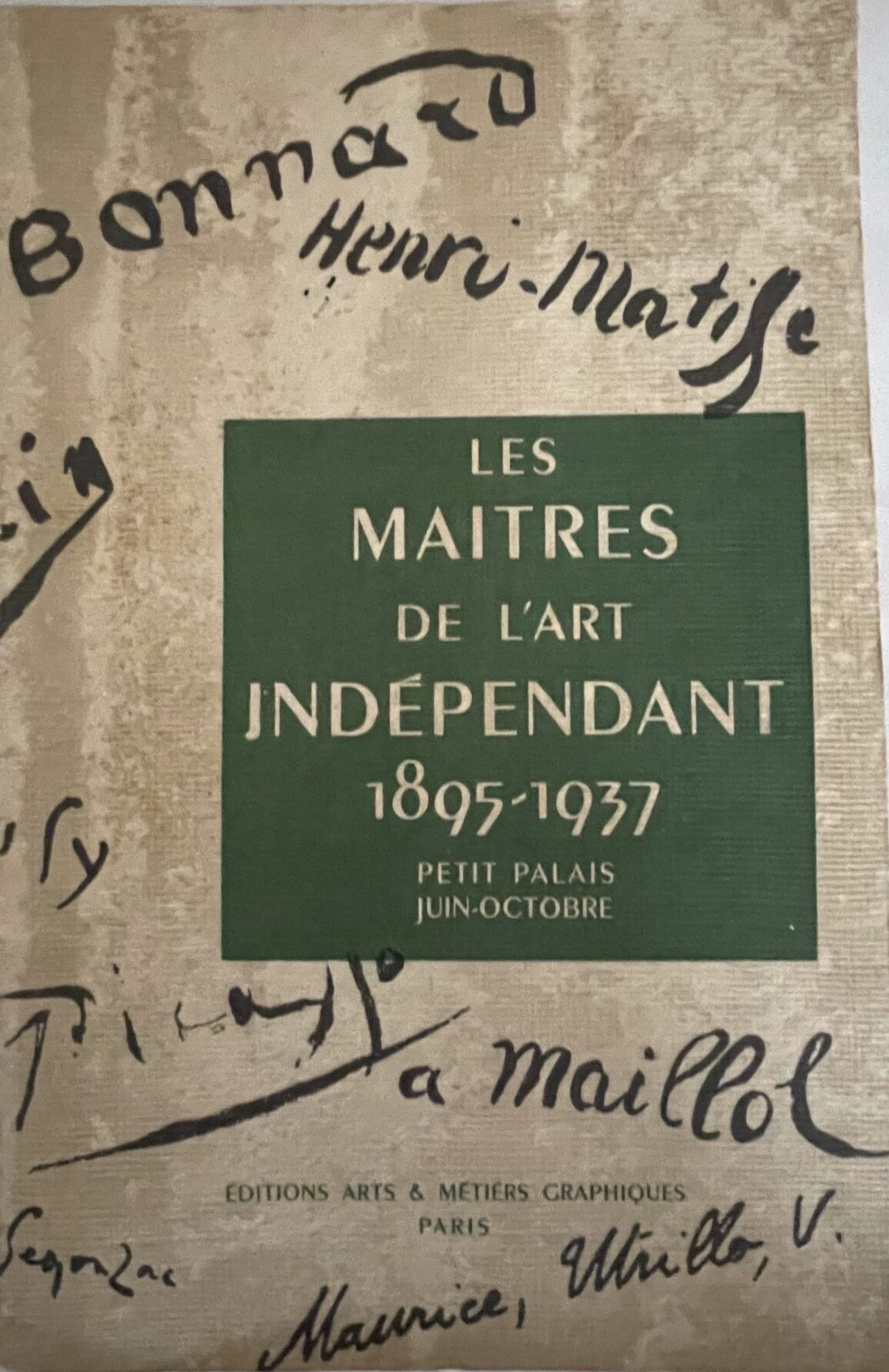Continuation of Blog <21> “Matisse Exhibition” (Tokyo Metropolitan Art Museum) and “Dream”
This blog is a continuation of
<21> “Matisse Exhibition” (Tokyo Metropolitan Art Museum) and “Dream”.
(If you haven’t read <21> yet, I recommend reading that first.)
In <21>, I introduced the “Matisse Exhibition” currently being held at the Tokyo Metropolitan Art Museum.
And also introduced the fact that I “discovered” that I ”The Dream”, which is exhibited at the exhibition this time, was exhibited at the “Masters of Independent Art Exhibition 1895-1937” held from June to October, as part of the 1937 Paris Universal Exposition.
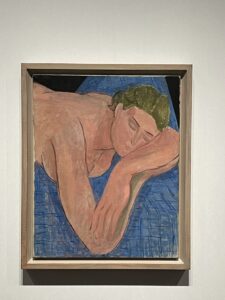
アンリ・マティス『夢』
Henri Matisse “The Dream”
In “Matisse Biography” from the exhibition catalog P258 of “Matisse Exhibition” this time, we can find the following statement.
*
In 1937, Raymond Escholier held the exhibition ” Masters of Independent Art Exhibition 1895-1937″ at the Petit Palais Museum, and Matisse also appeared.
*
However, far from “Matisse also appeared”, Matisse exhibited 61 works, the largest number, at the “Masters Exhibition” at the 1937 Paris Universal Exposition.
So, I wrote the following on <21>’s blog.
*
However, as mentioned above, 61 works by Matisse were exhibited, so if the works exhibited in this Matisse exhibition were made before 1937, it is possible that they were exhibited at the Expo.
I’m wondering if I can get this specific list of 61 points, but so far I haven’t found one.
(Currently under investigation. I’ll let you know if I find anything.)
*
Actually, even after that, I was looking into various things to see if I could get a list of the works exhibited at this “Masters Exhibition”.
Then, although I couldn’t find the exact information on the net, I found information on a book that seemed to be.
Discovered the catalog of “ Masters of Independent Art Exhibition 1895-1937“
While searching variously, on a site called AbeBooks.com, I found a book that looked exactly like the catalog of the “Masters of Independent Art 1895-1937” exhibition.
Title: Les maîtres de l’art indépendant 1895-1937. Juin – Octobre Petit Palais.
Author: (Petit Palais)
Quantity: 1
Book Description: Illustrated catalog of an exhibition celebrating the rôle of the Petit Palais in promoting avant-garde art in Paris over the previous forty years. set up by and for those artists who had had their work rejected by the official Salon), and the artists featured include a wealth of famous names from fauvism, cubism, dadaism and othe…
Binding: Soft cover
Book Price: US$ 64.08
Shipping Price: US$ 15.02
The total is $79.1, which is over 10,000 yen, but if I hesitate here, it may disappear soon. It looks like there’s only one book left.
But is this AbeBooks.com site reliable?
I looked it up on the internet and found a page on Wikipedia,
“AbeBooks is a global e-commerce online marketplace with operations in seven countries. Sellers in over 50 countries offer books, fine art and collectibles.”
An there was furthermore information below.
“In January 2008, Amazon.com acquired AbeBooks and is now under its umbrella.”
If it’s an Amazon affiliated company, it would be fine to enter the credit card number, so I decided to make a hasty order.
That was on Saturday, June 10th.
And it arrived at Banpaku-tei, my house, on the evening of Thursday, June 22nd.
The book was written in 1937, so it is 86 years old. It is a very valuable book.
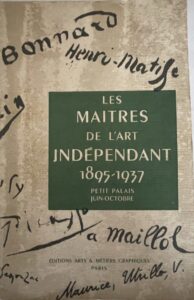
Catalog, Les Maitres de L’Art Indepéndant 1895-1937
But is there information in this book that I really want to know?
With both anticipation and anxiety, I picked up the book that looks dated. It’s been years since I’ve read a book with such excitement. I carefully and slowly turned the pages of the old book, which was peeling off here and there, so as not to damage it.
Matisse-related information in the catalog of the exhibition ” Masters of Independent Art Exhibition 1895-1937“
I found the information I was looking for.
On page 36, there is a portrait of Matisse, and below that is Henri Matisse in print and his signature. And below that is the list of works.
On the page on the right (page 37), there is an image of that “The Dream”.
The caption reads, “No.10. Le Rêve (The Dream).”
The next page 38 is also a list of Matisse’s works. Below is a picture of the sculpture. The title caption is simply “Sculpture”.
On the page to its right (page 39) is an image captioned “No. 35. Le Chapeau Jaune (‘Yellow Hat’).”
And above it says “Salle 7″.
In other words, Matisse’s works were exhibited in “Room 7”.
Try to find out where the “Room 7” was.
On page 11 of this catalog, there is the floor plan of the Petit Palais, where I can see where Room 7 is located.
The Room 1 is where you enter from the front. You go to the left from there and turn to the right, and you can find it in the third room.
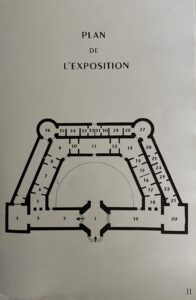
Plan de Lexposition, P11, Catalog of Les Maitres de L’Art Indepéndant 1895-1937
By the way, the Room 6 in the foreground displayed 30 works by André Derain (1880-1954), and the Room 8 next to the Matisse room displayed 42 works by Georges Rouault (1871-1958).
In addition, many “masters” we know were exhibiting at this exhibition.
For example, representatively,
Signac, Marie Laurencin (introduced in episode <19>), Denis, Vuillard, Bonnard, Rodin, Modigliani, Chagall, Utrillo, Léger, Picasso, and Braque.
They are prominent masters, and if it were now, it would be almost impossible to hold such an exhibition.
At that time, it may not have been as difficult as it is today because only existing painters’ works were gathered, but it is still an amazing exhibition.
Now let’s go back to Matisse.
The 61 works exhibited by Matisse are as follows.
(Please see the English translation of the titles for reference only, as I just translated them from French to English.)
61 works exhibited by Matisse
<Listed on page 36 of the catalog>
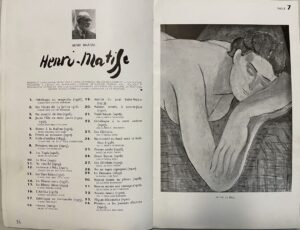
P36-37, Catalog of Henri Matisse Les Maitres de L’Art Indepéndant 1895-1937
- Odalisque au Magnolia (1926). Collection Gaston Bernheim
“Odalisque with Magnolia”
- Les Fleurs du 14 juillet 1918. Collection Gaston Bernheim
“Flowers of July 14, 1918”
- Nu couché de dos (1928).
“Lying nude seen from behind”
- Jeune Fille en robe jaune (1929-1931). Collection Miss Etta Cone
“Young Woman in a Yellow Dress”
- Femme a la fenêtre (1922). Musée Moderne, New York
“Woman at the Window”
- Femme au Tabouret (1912).
“Woman Sitting on a Stool”
- Coin d’Atelier (1899).
“The Corner of the Atelier”
- Poissons Rouges (1909). Collection Purrmann
“Goldfish”
- Les Tapis (1906).Musée de Grenoble
“Rug”
- Le Rêve (1935).
“The Dream”
- Nu Couché (1924).
“Lying Nude”
- Intérieur à Nice (1921). Collection De Mme Coodspeed
“Interior of a room in Nice”
- Les Yeux bleus (1932). Collection Miss Etta Cone
“Blue Eyes”
- La Blouse verte (1936).
“Green Blouse”
- La Blouse bleue (1935). Collection Bellanger
“Blue Blouse”
- L’Atelier (1916).Collection Particulière
“Atelier”
- Odalisque au Tambourin (1927). Collection Paley
“Odalisque with a tambourine”
- Liseuse (1905).Musée de Grenoble
“reading light”
- Atelier du quai Saint-Michel (1917).
“Atelier on the banks of the Saint-Michel”
- Nature Motre, a Contre-jour (1901).
“Backlit Still Life”
- Trois Soeurs (1916). Collection P. Guillaume
“Three Sisters”
- Odalissque à la Veste violette (1927). Collection P. Rosenberg
“Odalisque in the Purple Jacket”
- Les Glaïeul. Collection A. Kann
“Gladiolus”
- Nu Couché au fond Noir et Feillage (1936). Collection P. Rosenberg
“Nude Lying Against a Background of Black and Leaves”
- Femme Arabe (1928).Musée du Petit Palais
“Arab Woman”
- Deux Soeurs (1916). Collection A. Kann
“Two Sisters”
- Les Oliviers (1919).Musée du Petit Palais
“Olive Trees”
- Nu au Tapis Espagnol (1920).
“Spanish Carpet Nudity”
- La Dessert (1897).Kunsthalle de Bale
“Table”
- Nature Morte au plâtre (1928). Colleciton Rockfeller
“Gypsum Still Life”
- Nature Morte aux oranges (1912). Collection de Mme Sternheim
“Still Life with Oranges”
- Nature Morte (1920). Collection Josse Bernheim
“Still life”
- Figure Decorative (1922).
“Decorative Body” - Pianiste et les Joueurs d’Échecs (1920). Collection P. Rosenberg
“The Pianist and the Chess Player”
<Listed on page 37 of the catalog>
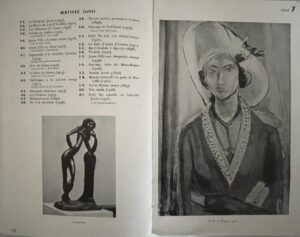
P38-39, Catalog of Les Maitres de L’Art Indepéndant 1895-1937
- Le Chapeau jaune (1929).
“Yellow Hat”
- La Route du cap d’Antibes (1921).
“Road to Cape Antibes”
- Les Oliviers de Corse (1898).
“Olive Trees of Corsica”
- Femme au violon (1921). Collection P. Guillaume
“Woman with Violin”
- Jeune Fille en Robe noire (1918). Collection Kann
“Young Woman in a Black Dress”
- Jeune Fille au Livre (1918). Collection P. Rosenberg
“Girl with a Book”
- Espagnole à la Mantille blanche (1923). Collection Josse Bernheim
“Spanish Woman in White Mantilla”
- Tête de Femme (1916). Collection P. Rosenberg
“Woman’s Head”
- Le Pont de Sèvres (1919). Musée du Petit Palais
“Bridge of Sèvres”
- Odalisque à la Culotte rouge (1921). Collection Gaston Bernheim
“ Odalisque with Red Trousers “
- Danseuse Classique (1927).
“Classic Dancer”
- Les Citrons (1927).
“Lemon”
- Moissonneurs (1896).
“Reaper”
- Nu à la Cheminée (1936).
“Nudity in the Fireplace”
- Nature Morte, Pommes et Citrons (1896).
“Still Life, Apples and Lemons”
- Paysage de Collioure (1905). Collection Molyneux
“Landscape of Collioure”
- Petit nu sur une Chaise-longue (1921).
“Little Nude Sitting on a Chaise Lounge”
- La Raie d’après Chardin (1901).
“The Ray After Chardin”
- Ma Chambre à Ajaccio (1898).
“My room in Ajaccio”
- Pianiste (1920).
“Pianist”
- Jeune Fille aux draperies rouges (1936).
“Young Woman in Red Cloak”
- Paysage, Coin du Mont-Boron (1920).
“Landscape, Corner of Mont Boron”
- Nature Morte (1896).
“Still Life”
- Bateau Camouflé au Port de Marseille (1916).
“The Disguised Ship in the Port of Marseille”
- Petite Nature Morte (1897).
“Small Still Life”
- Tête Noire (1916).
“Black Head” - Petit Nu Couché au bracelet jaune (1936). A Mme Delektorskaya
“Little Reclining Nude with a Yellow Bracelet”
Are there any works you were familiar with?
Which of the works exhibited at the “Matisse Exhibition” this time was exhibited at the 1937 Paris World Exposition “Masters Exhibition”?
Now, let’s finally compare these 61 works with the works exhibited at the “Matisse Exhibition” this time.
Since there are many similar titles, I try to check them one by one while using information on the year of production. It is quite a tough task.
As a result of that hard work, I was able to find two other possible works, in addition to “The Dream”.
Those are;
Odalisque à la Culotte rouge (1921). Collection Gaston Bernheim
“Odalisque with Red Culottes”
and,
Paysage de Collioure (1905). Collection Molyneux
“Landscape of Collioure”.
Make a research on “Landscape of Collioure”
Of these, about “Landscape of Collioure“, the English version of Wiki introduces a picture with the same title, produced in 1905, but with a different visual from the one in the Matisse exhibition. It is in the collection of the Museum of Modern Art (MOMA) in New York.
According to the materials of the “Masters Exhibition”, “Landscape of Collioure” belongs to the Collection Molyneux.
On the other hand, the catalog of the Matisse Exhibition this time has the caption “Menard Museum”, so it seems that it is owned by “Menard Museum”. When I accessed the website of the Menard Museum, I found this painting, but I don’t know if the work of the Menard Museum is from Collection Molyneux. Furthermore, the production year is “1905-1906”, which is slightly different from “1905”, so there is a possibility that it is a different work. However, of course, it is possible that the Menard Museum purchased it, and the year of production may have been revised with later information, so I will investigate further.
Well, first of all, what is this Collection Molyneux?
I found the following information on the website of the National Gallery in Washington D.C., USA.
*
Exhibition of French paintings from the Molyneux collection
March 2-May 11, 1952.
Ground Floor, Central Gallery
Overview: 73 small-scale pictures were lent by Captain Edward Molyneux, the noted dress designer of London and Paris, who had collected them since 1936 to decorate his Paris apartment. Included were 17 works by Auguste Renoir, 10 by Eugène Boudin, 7 by Edouard Vuillard, and works by Pierre Bonnard, Claude Monet, Vincent van Gogh, Georges Rouault, Henri Matisse, and other 19th- and 20th-century artists. Captain Molyneux came to Washington to arrange the installation of the pictures but had to return to France before the opening. National Gallery director John Walker later urged Ailsa Mellon Bruce to purchase this highly personal private collection en bloc for the National Gallery, and her name has been attached to it ever since.
Catalog: French Paintings from the Molyneux Collection. Washington, DC: National Gallery of Art, 1952.
Other Venues: Museum of Modern Art, New York
*
Next, I checked on the website of MOMA, which is said to be the current holding place.
I found the documentation, but I couldn’t find any more detailed information than the above.
However, I have heard that MOMA is also holding an exhibition of the Molineux Collection.
Combining all of this information, it is highly likely that the work exhibited in this “Masters Exhibition” is not from the collection of the Menard Museum, which is currently on display at the “Matisse Exhibition” in Tokyo, but is from the collection of MOMA. However, it is possible that there were two paintings with the same title in the Molyneux collection, so unfortunately we cannot identify it at this time.
Find out about “Red Culotte Odalisque”
Next is ” Odalisque with Red Trousers “.
If you search for this title, you’ll find two different works. They have exactly the same title. Annoying again.
Another one that is not exhibited at “Matisse Exhibition” this time seems to be owned by the Musée de l’Orangerie in Paris.
When I checked the website of the Orangery Museum, I was able to confirm that it was made in 1924-1925. So it’s not this work.
Since the work exhibited in this exhibition is from the collection of the Center Pompidou, I checked the website of the Center Pompidou. Then I found the following page.
Henri Matisse
Odalisque a la culotte rouge
[Automne 1921]
(Henri Matisse ” Odalisque with Red Trousers ” Autumn 1921)
There is a commentary page for this painting, and there is a commentary along with a photograph of the work exhibited at the “Matisse Exhibition” this time.
And in the third paragraph of the Bibliographie (References):
*
Les Maîtres de l”art indépendant 1895-1937 : Paris, Petit Palais, juin-octobre 1937. – Paris : Arts et métiers graphiques, 1937 (cat. n° 44 cit. p. 36, salle 7 (coll. Gaston Bernheim ))
Masters of Independent Art 1895-1937: Paris, Petit Palais, June-October 1937 – Paris: Graphic Arts and Crafts, 1937 (Catalog No. 44 citation, page 36, Room 7 (Gaston Bernheim))
*
This reference is the same catalog as the material I obtained this time.
That means that the Odalisque with Red Trousers exhibited at the “Matisse Exhibition” at the Tokyo Metropolitan Art Museum this time, was the one which was exhibited at the “Masters Exhibition” in 1937 Paris Exposition.
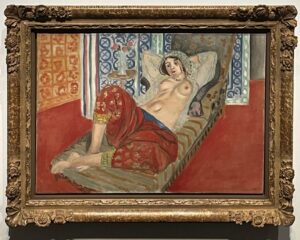
アンリ・マティス『赤いキュロットのオダリスク』
Henri Matisse “Odalisque à la culotte rouge”
As a result of trial and error, following “The Dream”, I was able to identify another work exhibited at a World Expo, which is, “Odalisque with Red Trousers “.
This “Matisse Exhibition” is a valuable opportunity to see works such as “The Dream” and “ Odalisque with Red Trousers,” which were exhibited at the 1937 Paris Exposition that was held 86 years ago.
I have to visit the exhibition again during the event.
